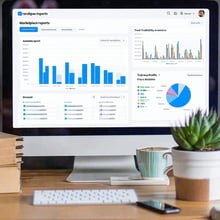
TMS Implementation Guide: From Selection to ROI (2025 Edition)
Implementing a Transportation Management System (TMS) is a critical decision that can transform your shipping operations. With the right approach, businesses typically see ROI within 6-8 months and achieve 30-40% cost savings on freight spend. This comprehensive guide will walk you through the entire TMS implementation process for 2025.
Understanding the Modern TMS Landscape
The TMS market has evolved significantly in recent years. Today's solutions offer:
-
Cloud-native architecture for faster deployment
-
AI-powered automation capabilities
-
Real-time analytics and reporting
-
Multi-carrier rate optimization
-
Automated freight booking
-
Predictive analytics for route optimization
Key Trends Shaping TMS in 2025
-
Integration of IoT devices for real-time tracking
-
Machine learning for predictive ETAs
-
Sustainability tracking and carbon footprint optimization
-
Advanced API connectivity
-
Mobile-first user interfaces
Phase 1: TMS Selection Process
Assessing Your Needs
Start by documenting your current processes and pain points:
-
Daily shipment volume
-
Current carrier mix
-
Integration requirements
-
Pain points in existing workflow
-
Growth projections for the next 3-5 years
Key Features to Consider
1. Core Transportation Features
-
Automated freight booking
-
Rate shopping across carriers
-
Document generation
-
Track and trace capabilities
2. Technical Requirements
-
Integration capabilities
-
API accessibility
-
Mobile functionality
-
Cloud infrastructure
3. Analytics and Reporting
-
Real-time dashboards
-
Custom report building
-
Predictive analytics
-
Cost analysis tools
Phase 2: Implementation Planning
Timeline Overview
Typical implementation timeline: 8-12 weeks
Week 1-2: Initial Setup
-
Project team assembly
-
Goal setting
-
Timeline establishment
-
Resource allocation
Week 3-4: System Configuration
-
Data migration planning
-
Carrier integration setup
-
User role definition
-
Initial system configuration
Week 5-6: Integration
-
API connections
-
ERP/WMS integration
-
EDI setup
-
Testing environments
Week 7-8: Testing
-
User acceptance testing
-
Integration testing
-
Performance testing
-
Error scenario testing
Week 9-10: Training
-
User training sessions
-
Process documentation
-
Standard operating procedures
-
Best practices guides
Week 11-12: Go-Live
-
Phased rollout
-
Performance monitoring
-
Support system activation
-
Feedback collection
Common Implementation Challenges & Solutions
1. Data Migration Issues
-
Solution: Thorough data cleaning pre-migration, validation protocols, backup systems.
2. User Adoption Resistance
-
Solution: Early stakeholder involvement, comprehensive training programs, clear communication of benefits.
3. Integration Complexities
-
Solution: Detailed API documentation, phased integration approach, regular testing cycles.
Phase 3: Measuring ROI
Key Performance Indicators (KPIs)
1. Cost Metrics
-
Freight spend reduction
-
Labor cost savings
-
Error rate reduction
-
Processing time improvement
2. Operational Metrics
-
Shipment processing time
-
Carrier compliance rate
-
On-time delivery performance
-
Document accuracy
3. Strategic Metrics
-
Customer satisfaction scores
-
Market expansion capability
-
Carrier relationship improvement
-
Environmental impact reduction
Typical ROI Timeframes
Short-term ROI (1-6 months)
-
90% reduction in manual data entry
-
15-20% immediate freight savings
-
80% decrease in processing time
Medium-term ROI (6-12 months)
-
30-40% total freight spend reduction
-
99.9% documentation accuracy
-
50% improvement in customer satisfaction
Long-term ROI (12+ months)
-
Strategic carrier relationship benefits
-
Market expansion capabilities
-
Improved negotiating power
-
Sustainable growth infrastructure
Case Study: TMS Implementation Success
Company Profile:
-
Mid-sized retailer
-
$50M annual revenue
-
200 daily shipments
-
Multiple warehouse locations
Implementation Results:
-
34% reduction in freight spend
-
92% decrease in manual processes
-
ROI achieved in 7 months
-
$1.2M annual savings
Best Practices for Success
1. Pre-Implementation
-
Clear goal setting
-
Stakeholder buy-in
-
Detailed process documentation
-
Resource allocation
2. During Implementation
-
Regular progress meetings
-
Incremental testing
-
User feedback collection
-
Clear communication channels
3. Post-Implementation
-
Continuous training
-
Performance monitoring
-
Regular system updates
-
Optimization reviews
Future-Proofing Your TMS Implementation
Consider these emerging trends:
-
AI/ML capabilities expansion
-
Blockchain integration
-
IoT device connectivity
-
Sustainability tracking
-
Real-time collaboration tools
Conclusion
A successful TMS implementation in 2025 requires careful planning, clear processes, and a focus on change management. By following this guide and working with experienced providers, you can ensure a smooth transition and maximize your ROI.
The key to success lies in thorough preparation, stakeholder engagement, and a commitment to continuous improvement. With the right approach, your TMS implementation can transform your transportation operations and drive significant business value.


Add Your Comment